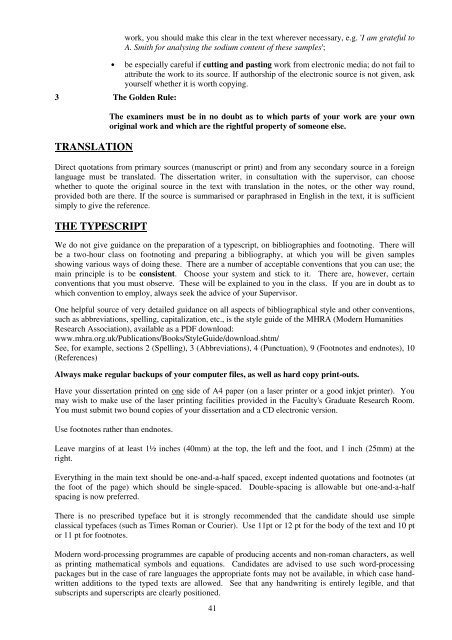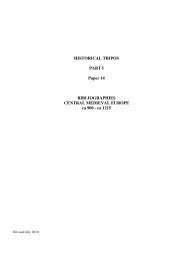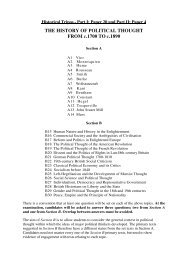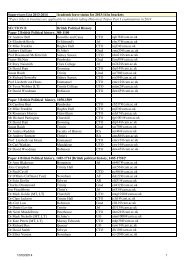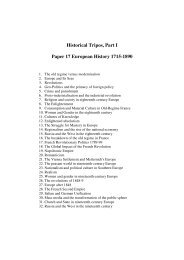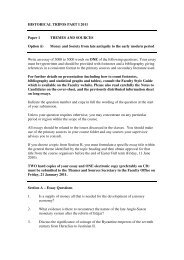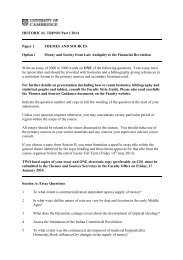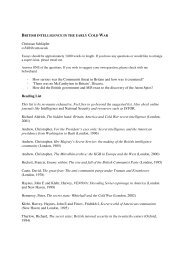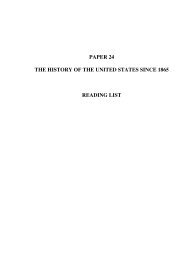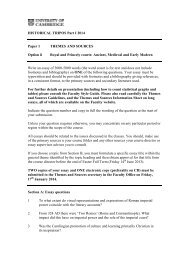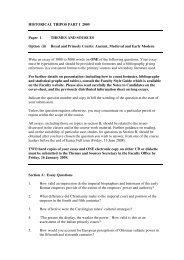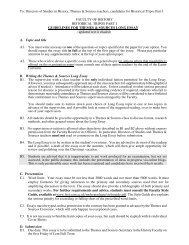Course Handbook - Faculty of History
Course Handbook - Faculty of History
Course Handbook - Faculty of History
Create successful ePaper yourself
Turn your PDF publications into a flip-book with our unique Google optimized e-Paper software.
work, you should make this clear in the text wherever necessary, e.g. 'I am grateful to<br />
A. Smith for analysing the sodium content <strong>of</strong> these samples';<br />
• be especially careful if cutting and pasting work from electronic media; do not fail to<br />
attribute the work to its source. If authorship <strong>of</strong> the electronic source is not given, ask<br />
yourself whether it is worth copying.<br />
3 The Golden Rule:<br />
TRANSLATION<br />
The examiners must be in no doubt as to which parts <strong>of</strong> your work are your own<br />
original work and which are the rightful property <strong>of</strong> someone else.<br />
Direct quotations from primary sources (manuscript or print) and from any secondary source in a foreign<br />
language must be translated. The dissertation writer, in consultation with the supervisor, can choose<br />
whether to quote the original source in the text with translation in the notes, or the other way round,<br />
provided both are there. If the source is summarised or paraphrased in English in the text, it is sufficient<br />
simply to give the reference.<br />
THE TYPESCRIPT<br />
We do not give guidance on the preparation <strong>of</strong> a typescript, on bibliographies and footnoting. There will<br />
be a two-hour class on footnoting and preparing a bibliography, at which you will be given samples<br />
showing various ways <strong>of</strong> doing these. There are a number <strong>of</strong> acceptable conventions that you can use; the<br />
main principle is to be consistent. Choose your system and stick to it. There are, however, certain<br />
conventions that you must observe. These will be explained to you in the class. If you are in doubt as to<br />
which convention to employ, always seek the advice <strong>of</strong> your Supervisor.<br />
One helpful source <strong>of</strong> very detailed guidance on all aspects <strong>of</strong> bibliographical style and other conventions,<br />
such as abbreviations, spelling, capitalization, etc., is the style guide <strong>of</strong> the MHRA (Modern Humanities<br />
Research Association), available as a PDF download:<br />
www.mhra.org.uk/Publications/Books/StyleGuide/download.shtm/<br />
See, for example, sections 2 (Spelling), 3 (Abbreviations), 4 (Punctuation), 9 (Footnotes and endnotes), 10<br />
(References)<br />
Always make regular backups <strong>of</strong> your computer files, as well as hard copy print-outs.<br />
Have your dissertation printed on one side <strong>of</strong> A4 paper (on a laser printer or a good inkjet printer). You<br />
may wish to make use <strong>of</strong> the laser printing facilities provided in the <strong>Faculty</strong>'s Graduate Research Room.<br />
You must submit two bound copies <strong>of</strong> your dissertation and a CD electronic version.<br />
Use footnotes rather than endnotes.<br />
Leave margins <strong>of</strong> at least 1½ inches (40mm) at the top, the left and the foot, and 1 inch (25mm) at the<br />
right.<br />
Everything in the main text should be one-and-a-half spaced, except indented quotations and footnotes (at<br />
the foot <strong>of</strong> the page) which should be single-spaced. Double-spacing is allowable but one-and-a-half<br />
spacing is now preferred.<br />
There is no prescribed typeface but it is strongly recommended that the candidate should use simple<br />
classical typefaces (such as Times Roman or Courier). Use 11pt or 12 pt for the body <strong>of</strong> the text and 10 pt<br />
or 11 pt for footnotes.<br />
Modern word-processing programmes are capable <strong>of</strong> producing accents and non-roman characters, as well<br />
as printing mathematical symbols and equations. Candidates are advised to use such word-processing<br />
packages but in the case <strong>of</strong> rare languages the appropriate fonts may not be available, in which case handwritten<br />
additions to the typed texts are allowed. See that any handwriting is entirely legible, and that<br />
subscripts and superscripts are clearly positioned.<br />
41


